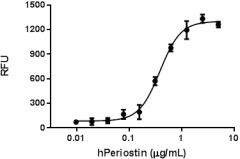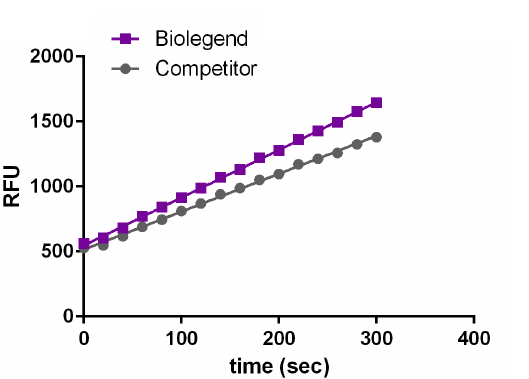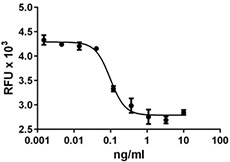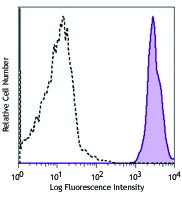- Regulatory Status
- RUO
- Other Names
- POSTN, PN, Osteoblast Specific Factor 2, OSF2, OSF-2
- Ave. Rating
- Submit a Review
- Product Citations
- publications

-

Recombinant human Periostin supports the adhesion of mouse chrondrogenic cell line ATDC-5 cells. ED50 for this effect is 0.2 – 0.8 µg/mL. Calcein-AM (Cat. No. 425201) was used to measure the number of adherent cells. -

Stability testing for human Periostin. Human Periostin was aliquoted in PBS, pH 7.2 at 0.2 mg/ml. One aliquot was freeze and thawed four times (4x freeze/thaws), and compared to a control kept at 4°C (control). The samples were tested for their ability to support the adhesion of ATDC-5 cells.
| Cat # | Size | Price | Quantity Check Availability | Save | ||
|---|---|---|---|---|---|---|
| 770506 | 100 µg | £353 | ||||
Periostin (POSTN), also known as OSF-2 (osteoblast specific factor 2), is a 90 kDa secreted matricellular protein originally identified for its high expression in periosteum and periodontal ligament. POSTN contains three domains with distinct functions. N-terminal cysteine-rich EMI domain binds collagen I, fibronectin, and Notch-1. Four tandem FAS1 domains bind BMP1, tenascin-C, and Integrins. C-terminal domain is a site of proteolytic cleavage and splice variant formation. POSTN interact with extracellular matrix and cell surface receptors enabling it to modulate both biomechanical properties of connective tissues and the cell-matrix interactions. POSTN enhances fibronectin and collagen I production and promotes collagen fibrillogenesis. It enhances cell migration and adhesion through binding integrins. POSTN is frequently overexpressed in various types of human cancers, stimulating metastatic growth by promoting cancer cell survival, invasion and angiogenesis. POSTN has been shown to be involved in the pathophysiology of several organs. It is induced following myocardial infarction, playing crucial role in collagen fibrilogenesis and cardiac healing. POSTN is also an important mediator and prognostic factor of lung disease.
Product DetailsProduct Details
- Source
- Human Periostin, amino acids Asn22-Gln779 (Accession # BC106710) with a C-terminal TG-8H-GGQ tag was expressed in 293E cells.
- Molecular Mass
- The 771 amino acid recombinant protein has a predicted molecular mass of approximately 86.2 kD. The DTT-reduced and non-reduced protein migrates at approximately 80 kD by SDS-PAGE. The predicted N-terminal amino acid is Asn.
- Purity
- >95%, as determined by Coomassie stained SDS-PAGE.
- Formulation
- 0.22 µm filtered protein solution is in PBS, pH 7.2
- Endotoxin Level
- Less than 0.1 EU per µg protein as determined by the LAL method.
- Concentration
- 10 and 25 µg sizes are bottled at 200 µg/mL. 100 µg size and larger sizes are lot-specific and bottled at the concentration indicated on the vial. To obtain lot-specific concentration and expiration, please enter the lot number in our Certificate of Analysis online tool.
- Storage & Handling
- Unopened vial can be stored between 2°C and 8°C for up to 2 weeks, at -20°C for up to six months, or at -70°C or colder until the expiration date. For maximum results, quick spin vial prior to opening. The protein can be aliquoted and stored at -20°C or colder. Stock solutions can also be prepared at 50 - 100 µg/mL in appropriate sterile buffer, carrier protein such as 0.2 - 1% BSA or HSA can be added when preparing the stock solution. Aliquots can be stored between 2°C and 8°C for up to one week and stored at -20°C or colder for up to 3 months. Avoid repeated freeze/thaw cycles.
- Activity
- ED50= 0.2 - 0.8 µg/mL as measured by the ability of immobilized protein to support the adhesion of mouse chrondrogenic cell line ATDC-5 cells. Calcein-AM (Cat. No. 425201) was used to measure the number of adherent cells.
- Application
-
Bioassay
Antigen Details
- Distribution
-
Widely expressed with highest levels in aorta, stomach, lower gastrointestinal tract, placenta, uterus, thyroid tissue and breast. Up-regulated in epithelial ovarian tumors. Not expressed in normal ovaries. Also highly expressed at the tumor periphery of lung carcinoma tissue but not within the tumor. Overexpressed in breast cancers.
- Function
- Induces cell attachment and spreading and plays a role in cell adhesion, enhances incorporation of BMP1 in the fibronectin matrix of connective tissues.
- Ligand/Receptor
- BMP1, tenascin-C, Integrins, collagen I, fibronectin, and Notch-1.
- Bioactivity
- Measured by the ability of immobilized protein to support the adhesion of mouse chrondrogenic cell line ATDC-5 cells.
- Biology Area
- Cell Adhesion
- Antigen References
-
- Takeshita S, et al. 1993. Biochem. J. 294:271-278.
- Gillan L, et al. 2002. Cancer Res. 62:5358-5364.
- Shao R, et al. 2004. Mol Cell Biol. 24:3992-4003.
- Kuhn B, et al. 2007. Nat Med. 13:962-969.
- Lindner V, et al. 2005. Arterioscler Thromb Vasc Biol. 25:77-83.
- Yan W, et al. 2006. J Biol Chem. 281:19700.
- Erkan M, et al. 2007. Gastroenterology. 132:1447.
- Snider P, et al. 2008. Circ Res. 102:752.
- Gene ID
- 10631 View all products for this Gene ID
- UniProt
- View information about Periostin on UniProt.org
Related Pages & Pathways
Pages
Related FAQs
- Why choose BioLegend recombinant proteins?
-
• Each lot of product is quality-tested for bioactivity as indicated on the data sheet.
• Greater than 95% Purity or higher, tested on every lot of product.
• 100% Satisfaction Guarantee for quality performance, stability, and consistency.
• Ready-to-use liquid format saves time and reduces challenges associated with reconstitution.
• Bulk and customization available. Contact us.
• Learn more about our Recombinant Proteins. - How does the activity of your recombinant proteins compare to competitors?
-
We quality control each and every lot of recombinant protein. Not only do we check its bioactivity, but we also compare it against other commercially available recombinant proteins. We make sure each recombinant protein’s activity is at least as good as or better than the competition’s. In order to provide you with the best possible product, we ensure that our testing process is rigorous and thorough. If you’re curious and eager to make the switch to BioLegend recombinants, contact your sales representative today!
- What is the specific activity or ED50 of my recombinant protein?
-
The specific activity range of the protein is indicated on the product datasheets. Because the exact activity values on a per unit basis can largely fluctuate depending on a number of factors, including the nature of the assay, cell density, age of cells/passage number, culture media used, and end user technique, the specific activity is best defined as a range and we guarantee the specific activity of all our lots will be within the range indicated on the datasheet. Please note this only applies to recombinants labeled for use in bioassays. ELISA standard recombinant proteins are not recommended for bioassay usage as they are not tested for these applications.
- Have your recombinants been tested for stability?
-
Our testing shows that the recombinant proteins are able to withstand room temperature for a week without losing activity. In addition the recombinant proteins were also found to withstand four cycles of freeze and thaw without losing activity.
- Does specific activity of a recombinant protein vary between lots?
-
Specific activity will vary for each lot and for the type of experiment that is done to validate it, but all passed lots will have activity within the established ED50 range for the product and we guarantee that our products will have lot-to-lot consistency. Please conduct an experiment-specific validation to find the optimal ED50 for your system.
- How do you convert activity as an ED50 in ng/ml to a specific activity in Units/mg?
-
Use formula Specific activity (Units/mg) = 10^6/ ED50 (ng/mL)
 Login / Register
Login / Register 












Follow Us